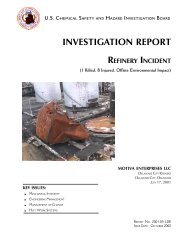CTA Report, Draft 1, ISP Review - US Chemical Safety and Hazard ...
CTA Report, Draft 1, ISP Review - US Chemical Safety and Hazard ...
CTA Report, Draft 1, ISP Review - US Chemical Safety and Hazard ...
You also want an ePaper? Increase the reach of your titles
YUMPU automatically turns print PDFs into web optimized ePapers that Google loves.
operating the oven with the doors open was not evaluated. On the day of the incident, combustible<br />
material in the oven probably caught on fire, <strong>and</strong> flames likely ignited a dust cloud that was created by<br />
cleaning activity. NFPA 654 (2000) states: “[W]ritten procedures to manage change to process<br />
materials, technology, equipment, procedures, <strong>and</strong> facilities shall be established <strong>and</strong> implemented.”<br />
8.6 Maintenance<br />
The production lines were shut down once every 6 to 9 weeks for maintenance <strong>and</strong> cleaning.<br />
Maintenance activity typically included removing accumulated combustible material in the bottom of the<br />
ovens, s<strong>and</strong>blasting oven interiors, <strong>and</strong> replacing the bags in the baghouses.<br />
The last maintenance shutdown of line 405 took place on December 19, 2002—9 weeks prior to the<br />
incident. The next shutdown was initially scheduled for February 13, 2003; postponed until February 20;<br />
<strong>and</strong> then rescheduled a second time for February 21. The incident occurred on February 20.<br />
Employees reported that the delay in replacing bags in the baghouse caused increasing amounts of dust to<br />
escape from the production line <strong>and</strong> into the work area. The differential pressure gauge on the baghouse<br />
showed that suction was outside of the manufacturer’s limits. NFPA 654 (2000) recommends pressure<br />
drops of 3 to 5 inches of water to maximize baghouse efficiency. According to CSB interviews with line<br />
crew employees, the baghouse differential pressure was running above 6 inches on February 19, the day<br />
before the incident. Interviews also revealed that line 405 was much dustier than normal.<br />
8.6.1 Oven Operation <strong>and</strong> <strong>Safety</strong><br />
Oven temperature control equipment on line 405 had not been working properly for a few weeks prior to<br />
the incident. CSB interviews with line 405 employees revealed that the oven was running too hot.<br />
Electricians were unable to fix the problem. Operators compensated by opening two of the oven doors to<br />
cool it down. Supervisors <strong>and</strong> workers did not view the temperature control problem as a safety concern.<br />
75









